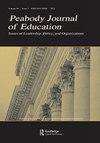School vs. District Level Views of School Spending Inequality and Progressivity: Evidence from Florida and Illinois
Q2 Social Sciences
引用次数: 1
Abstract
ABSTRACT How much does spending vary across US public schools? And how much do the schools that low-income students attend spend compared to schools attended by their more advantaged peers? Students are educated in schools, which are frequently segregated by race and socioeconomic status, and spending can vary across schools within the same district. But this variation is invisible in revenue and expenditure data reported and analyzed at the district level, rather than school level, as has typically been done in the school finance literature to date (because of data limitations). Because the scope for within-district spending inequality is greater in larger districts that have many schools, differences in the number of schools per district may distort comparisons across states. To illustrate this phenomenon we analyze two states: Florida, which has 67 regular school districts, and Illinois, which enrolls fewer students in total, but has nearly 900 regular school districts. We construct measures of inequality and progressivity using school-level and district-level data. We show that across-school, within-district inequality is indeed higher in Florida than in Illinois. As expected, comparisons of inequality and progressivity based on district-level averages exaggerate the differences between the two states.学校与地区对学校支出不平等和累进性的看法:来自佛罗里达州和伊利诺伊州的证据
美国公立学校的教育经费差异有多大?低收入家庭学生就读的学校与条件较好的同龄人就读的学校相比,花了多少钱?学生们在学校接受教育,这些学校经常被种族和社会经济地位隔离,同一地区的不同学校的支出可能不同。但是,这种变化在地区一级报告和分析的收入和支出数据中是不可见的,而不是在学校一级,这是迄今为止学校财政文献中通常做的(由于数据限制)。由于学区内支出不平等的范围在拥有许多学校的大学区更大,每个学区学校数量的差异可能会扭曲各州之间的比较。为了说明这一现象,我们分析了两个州:佛罗里达州有67个普通学区,而伊利诺伊州的学生总数较少,但有近900个普通学区。我们使用学校级和地区级数据构建不平等和累进性的度量。我们的研究表明,佛罗里达州的跨学校、学区内的不平等程度确实高于伊利诺伊州。正如预期的那样,基于地区平均水平的不平等和累进性的比较夸大了两个州之间的差异。
本文章由计算机程序翻译,如有差异,请以英文原文为准。
求助全文
约1分钟内获得全文
求助全文
来源期刊

Peabody Journal of Education
Social Sciences-Education
CiteScore
2.20
自引率
0.00%
发文量
43
期刊介绍:
Peabody Journal of Education (PJE) publishes quarterly symposia in the broad area of education, including but not limited to topics related to formal institutions serving students in early childhood, pre-school, primary, elementary, intermediate, secondary, post-secondary, and tertiary education. The scope of the journal includes special kinds of educational institutions, such as those providing vocational training or the schooling for students with disabilities. PJE also welcomes manuscript submissions that concentrate on informal education dynamics, those outside the immediate framework of institutions, and education matters that are important to nations outside the United States.
 求助内容:
求助内容: 应助结果提醒方式:
应助结果提醒方式:


